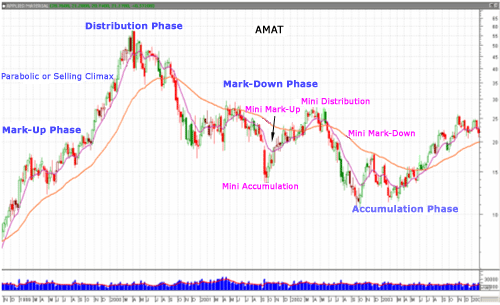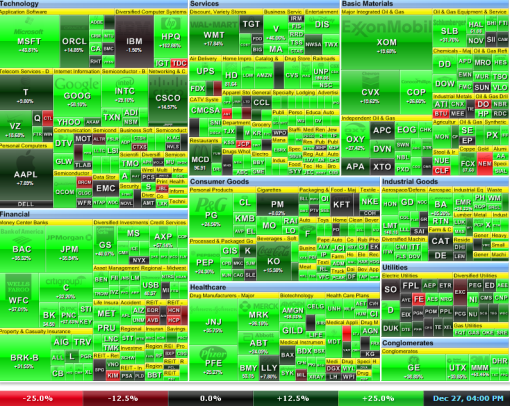Are you tired of constantly buying at market highs and being disappointing when the stock or index falls shortly after purchasing your favorite stock?
If you learn to recognize the patterns of the market and use the phases that money managers use to your advantage, you will have the upper-hand and produce colossal returns. Smart-money investors study, analyze and understand the four cycles that occur in every stock or index: Accumulation, Mark-Up, Distribution and Mark-Down.
Accumulation: This is the first phase when the market has bottomed (or very close to bottoming) and the value investors, smart-money and sophisticated traders start to accumulate stock at deep discounts. During this phase, the majority of investors are still bearish in the market and are sitting on cash, frightened by the negative outlook from the media and peers.
Mark-Up: During this phase, smart-money has already been accumulating, causing prices to rise (mark-up) and the market appears to be rebounding and stabilizing. This phase is when some retail investors (not many) start buying into the market, causing prices to inflate even more. At this point, the media starts discussing the possibility of the worse being over. During the end of the phase, more and more investors feel comfortable that the market is stabilizing and do not want to miss out on gains that their friends and co-workers are making from the recent rise in the market. At the end of the phase, everyone is now bullish and confident in the market, resulting in a strong uptrend.
Distribution: In this third phase, smart-money recognizes their nice gains they have realized since phase one (Accumulation) and start selling. This selling by smart-money pulls the market back and investors start experiencing mixed feelings (bearish and bullish). Once the selling outweighs the buying, investors start to get nervous with the market correction and high valuations. This causes the majority sentiment to change and investors who bought in during the Mark-Up phase start selling like wildfire. This typically results in a small profit, break-even or a small loss.
Mark-Down: Lastly, in the Mark-Down phase, sentiment is very bearish and it hurts to sell for those who bought at the top, but they sell off and realize significant losses. Many investors in this phase do not want to sell at this point because they think there is still a chance for a market re-bound, but it takes too long and they end up selling at a very low price. At the end of this phase, this is when smart-money gets excited because of all the discounts on stocks. and they start buying up as much stock as possible. This soon transitions into the Accumulation phase.
It’s not fun for investors who are constantly buying high and selling low, but learning to recognize market patterns can significantly improve your chances of outperforming the market. After all, the market is a game. It is a game of psychology, made up of those who are greedy, paralyzed by fear and those who know how to smell the fear in the market and act on others fear.
I’ll close with a quote by Warren Buffett:“Be fearful when others are greedy and greedy when others are fearful.”

